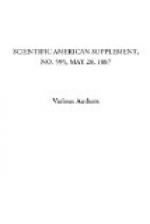It was clearly established before the committee that not all potatoes were equally liable to the disease. The liability depends upon strength of constitution. It is well known that potatoes are usually, almost invariably, propagated by “sets,” that is, by planting tubers, or portions of tubers, and this method of propagation is analogous to the propagation of other forms of plants by means of “cuttings.” When potatoes are raised from seed, it is found that some of the “seedlings” present a strength of constitution which enables them to resist the disease for some years, even though the subsequent propagation of the seedling is entirely from “sets.” The raising of seedling potatoes is a tedious process, but the patience of the grower is often rewarded by success, and I may allude to the fact that the so-called “Champion potato,” raised from seed in the first instance by Mr. Nicoll, in Forfarshire, and since propagated all over the country, has enjoyed, deservedly as it would appear, a great reputation as a disease-resisting potato; but all who have a practical knowledge of potato growing seem agreed that we cannot expect its disease-resisting quality to last at most more than twenty years from its first introduction (in 1877), and that in time the constitution of the “Champion” will deteriorate, and it will become a prey to disease.
There is some evidence to show, also, that the constitution of the potato may be materially influenced by good or bad culture. Damp soils, insufficient or badly selected manures, the selection of ill developed potatoes for seed, and the overcrowding of the “sets” in the soil, all seem to act as causes which predispose the potatoes to the attacks of the parasite. Strong potatoes resist disease, just as strong children will; while weak potatoes, equally with weak children, are liable to succumb to epidemic influences.
The following account of some exact experiments carried out by Mr. George Murray, of the Botanical Department of the British Museum, seems to show that Mr. Carruthers’ theory as to the diffusion of conidia through the air is something more than a speculation:
“In the middle of August, 1876,” says Mr. Murray, “I instituted the following experiments, with the object of determining the mode of diffusion of the conidia of Peronospora infestans.
“The method of procedure was to expose on the lee side of a field of potatoes, of which only about two per cent, were diseased, ordinary microscopic slides, measuring two inches long by one inch broad, coated on the exposed surface with a thin layer of glycerine, to which objects alighting would adhere, and in which, if of the nature of conidia, they would be preserved. These slides were placed on the projecting stones of a dry stone wall which surrounded the field, and was at least five yards from the nearest potato plant. During the five days and nights of the experiment, a gentle wind blew, and the weather was, on the whole, dry and clear. Every morning, about nine o’clock, I placed fourteen slides on the lee side of the field, and every evening, about seven o’clock, I removed them, and placed others till the following morning at nine o’clock. The fourteen slides exposed during the day, when examined in the evening, showed (among other objects):




